Chronic Gout
Chronic Gout
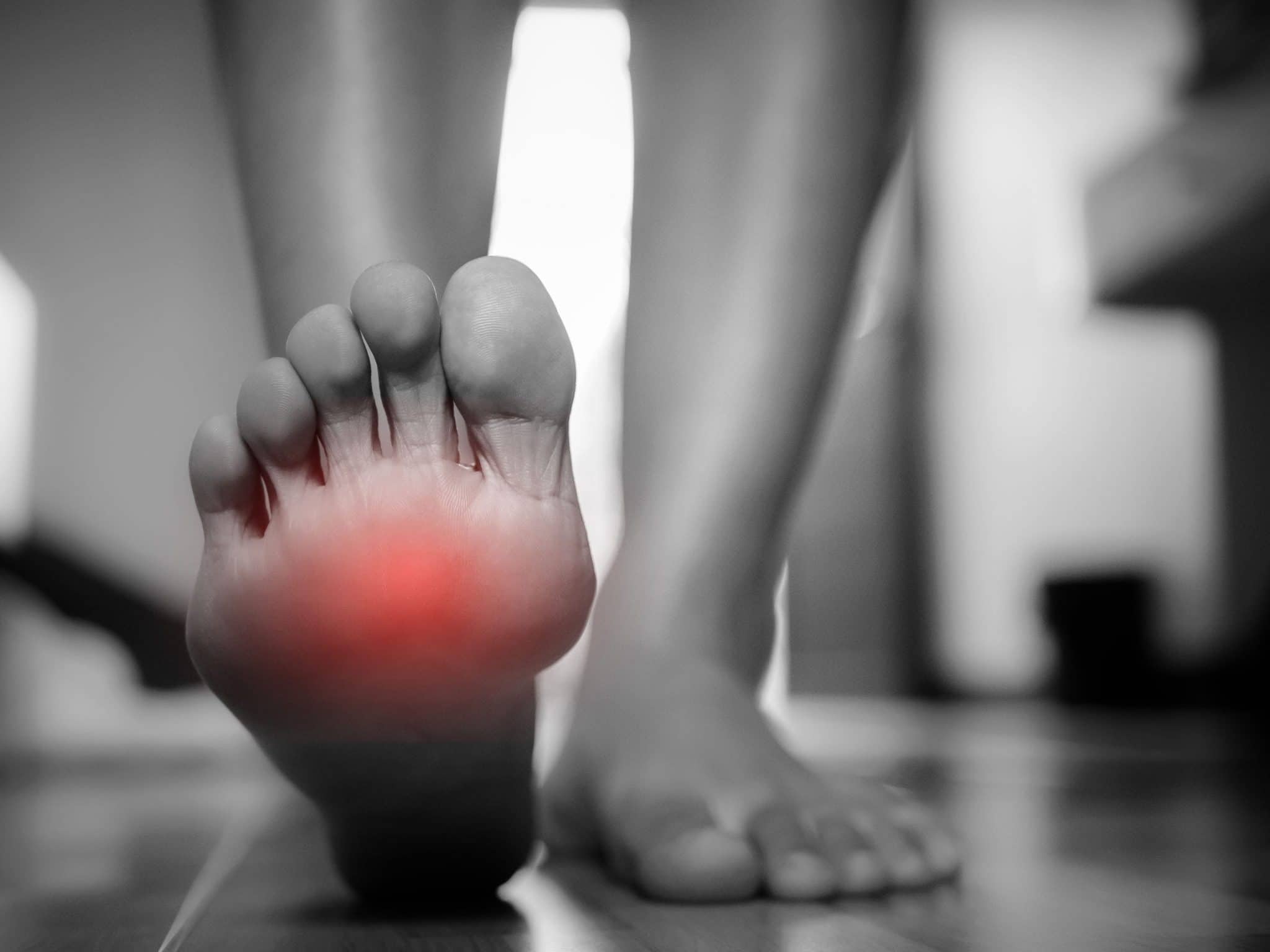

Back to top
Contents
- MAKING A LIFELONG ADJUSTMENT TO LIVING WITH GOUT
- MANAGING CHRONIC GOUT.
- THE ROOT CAUSE OF GOUT
- WHO IS AT RISK OF DEVELOPING GOUT?
- FOODS THAT CAN INCREASE URIC ACID LEVELS TYPICALLY INCLUDE
- TREATMENT
- LONG TERM MANAGEMENT
- GOUT AND KIDNEY DISEASE
- LIFESTYLE MODIFICATIONS
- LONG TERM OUTLOOK
- WHAT DO THESE MEDICAL TERMS MEAN?
Back to top
MAKING A LIFELONG ADJUSTMENT TO LIVING WITH GOUT
International guidelines on the management of gout advocate that patient education is essential, including firstly the principles of causation, secondly managing acute attacks and thirdly the importance of effective long-term treatments.1a
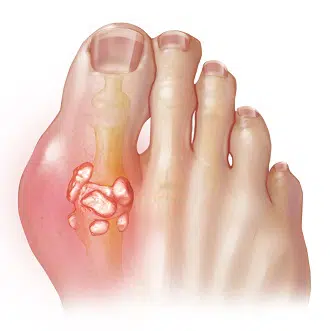
Back to top
WHY IS IT IMPORTANT TO LEARN ABOUT CHRONIC GOUT?
Gouty arthritis can lead to chronic disability and furthermore, joint damage can get progressively worse.1j,3b Moreover, chronic gout increases the risk of developing osteoarthritis and increases the risk of kidney disease.2d,3b However, long term management with effective medicines can slow down the progression of the disease.1b,5b
Back to top
MANAGING CHRONIC GOUT.
In essence, there are 3 basic principles for the effective management of gout. They are the following:
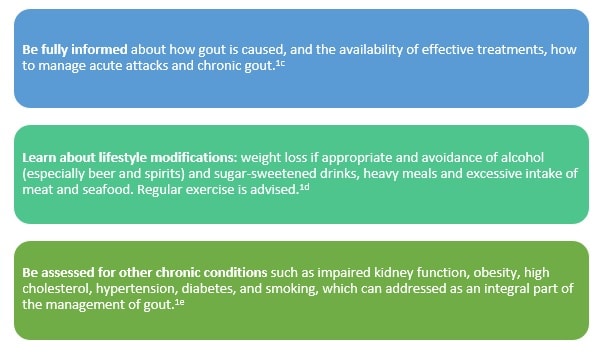
Back to top
THE ROOT CAUSE OF GOUT: URIC ACID
High levels of uric acid in the body is known as hyperuricaemia which could certainly lead to other conditions like gout.2e,3a Why does this happen? One reason is that your body might ‘make’ too much uric acid, while another reason may be that your body has difficulty getting rid of it. As a result, there is an abundance of uric acid circulating in the blood, leading to the formation of uric acid crystals in the joints. Thereafter the crystals cause the joint to become inflamed, causing pain, swelling and warmth.2e
Back to top
WHO IS AT RISK OF DEVELOPING GOUT?
- Firstly, it is important to know that most often the uric acid in the blood becomes abnormally high when the kidneys cannot eliminate enough of it in the urine. Moreover, conditions that impair the kidney function include kidney disease, high blood pressure and diabetes, putting these people at higher risk of developing gout.1j,3b
- Secondly, some medications such as diuretics (water pills) used to treat high blood pressure may increase the uric acid level in the blood.2f
- Thirdly, consuming too much purine-rich food can also increase the uric acid level in the blood and what is more, combining a high-purine diet with alcohol or beverages containing high fructose corn syrup can worsen matters.3d,e
Back to top
FOODS THAT CAN INCREASE URIC ACID LEVELS TYPICALLY INCLUDE
- Liver, kidney3d
- Anchovies3d
- Asparagus3d
- Meat gravies and broths3d
- Mushrooms3d
- Mussels, sardines and herring3d
- Sweetbreads3d
Back to top
TREATMENT
Gout treatment has the following 3 goals:3f

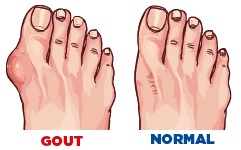
Back to top
LONG TERM MANAGEMENT:
Gout is the only arthritis that can be alleviated with Urate-Lowering Therapy1. People that suffer from chronic gout may be prescribed a treatment called Urate-Lowering Therapy (ULT), which lowers the uric acid level in the blood. Lowering these levels to less than 6 mg / dL is needed to prevent deposits of uric acid. 2h,3k When the level is maintained under 6 mg / dL then it will stop being deposited into tissues and existing deposits will eventually dissolve.3k The benefits of this daily urate-lowering therapy are not only seen in long-term control of flare-ups but also in the prevention of chronic damage to the kidneys and joints.5b,c These medicines are required if you have the following:1f,2h,5d
- Frequent, severe flare-ups (more than 2 during the same year) despite taking colchicine or other painkillers
- Damage to joint and tophi (lumps under the skin)2k
- Kidney disease or kidney stones
Back to top
GOUT AND KIDNEY DISEASE
High levels of uric acid in the blood are associated with increased risk of kidney disease.2d For these people in particular, there is a higher likelihood of gout progression and development of tophi.5b On the other hand, taking medicines to lower uric acid can prevent progression of gout with added benefit of preventing progression of kidney disease.5b
Back to top
LIFESTYLE MODIFICATIONS

Back to top
LONG TERM OUTLOOK
Treating gout patients to prevent crystal formation and promote crystal dissolution has been a principle of management for more than 50 years!1h,i With early diagnosis, treatment enables most people to live a normal life.2j Furthermore, for many people with advanced disease, lowering uric acid blood levels can resolve tophi and improve joint function and quality of life.1h,3l Brought to you by Aspen in the interests of patient education. This information is provided for educational purposes and does not replace the advice from your Doctor. For more information please consult your Doctor or Pharmacist.
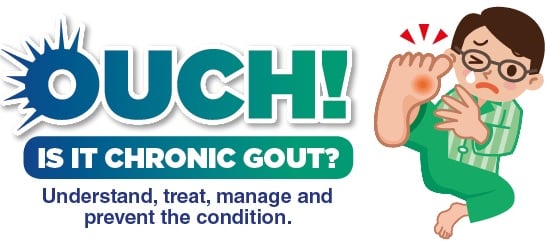
Back to top
WHAT DO THESE MEDICAL TERMS MEAN?
Tophus/Tophi Deposits of uric acid can form lumps below the skin around a joint. The lump is called a tophus. Multiple lumps (tophi) develop after a person has had gout for many years.2k Uric acid A by-product of nucleic acids (DNA and RNA) in cells and from purines in food.3m Hyperuricaemia High blood levels of uric acid.3a A uric acid level in the blood over 7 mg/dL is considered high.2l Kidney stones Medically called urolithiasis, kidney stones form in the urine and are composed of uric acid.3b Urate-lowering therapy (ULT) Prescription medication taken every day to lower uric acid level in the blood which prevents crystal formation and promotes crystal dissolution.
Click here to read more about GOUT (you are about to leave the Medinformer website)
More on Managing Gout

Medical References
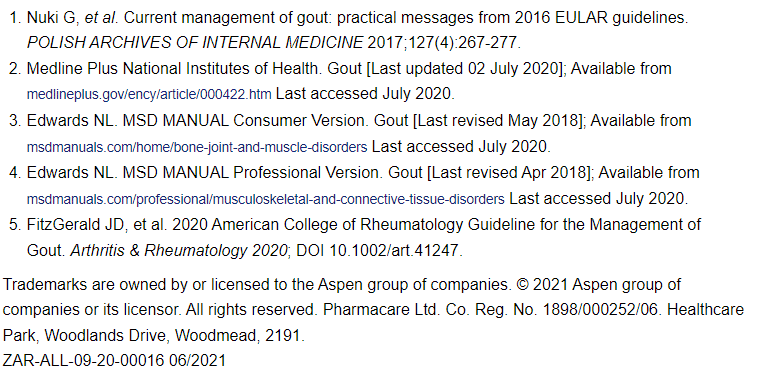
November 2, 2021
Content Disclaimer:
You understand and acknowledge that all users of the Dis-Chem website or app are responsible for their own medical care, treatment, and oversight. All of the content provided on the website, are for INFORMATIONAL PURPOSES ONLY and DOES NOT CONSTITUTE THE PROVIDING OF MEDICAL ADVICE and is not intended to be a substitute for independent professional medical judgment, advice, diagnosis, or treatment. The content is not intended to establish a standard of care to be followed by a user of the website. You understand and acknowledge that you should always seek the advice of your physician or other qualified health provider with any questions or concerns you may have regarding your health. You also understand and acknowledge that you should never disregard or delay seeking medical advice relating to treatment or standard of care because of information contained in or transmitted through the website. Medical information changes constantly. Therefore the information on this website or on the linked websites should not be considered current, complete or exhaustive, nor should you rely on such information to recommend a course of treatment for you or any other individual. Reliance on any information provided on this website or any linked websites is solely at your own risk.








